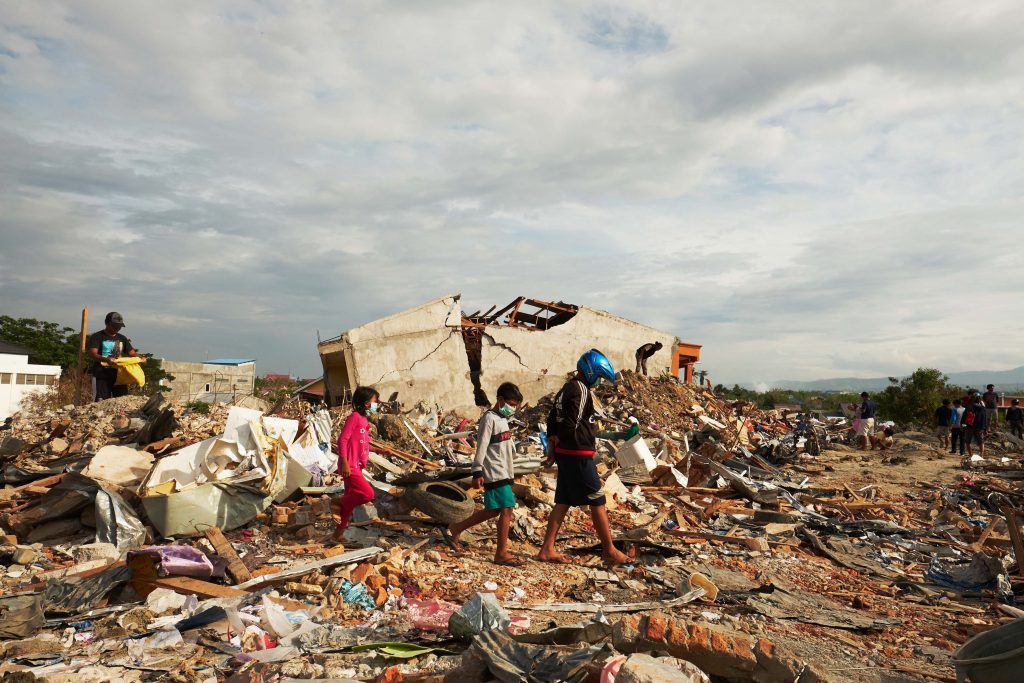On 28 September 2018, Palu was hit by a 5-metre-high tsunami shortly after a magnitude 7.5 earthquake struck and area 80 km north of the city. The combined effects of the earthquake and tsunami led to the deaths of at least 2,100 people and many more missing. The earthquake caused major soil liquefaction, which meant many buildings were swallowed up by the ground.

My initial plans were to visit Indonesia for a month or so, but this would have been after Christmas. However immediately upon hearing about the sheer scale of this disaster, I wanted to get out there and try to help; to show the disaster and give people a voice, while finding out what they needed.

The first part of the journey took me from London to Jakarta. There is normally a direct flight to Palu, but due to damage to the airport, planes are currently unable to land. From Jakarta, I had to take a smaller plane with propellers via Makkasar (a port city on the eastern side of Sulawesi Island) to Palu. The flight was full of local NGO workers bringing as many supplies as they were allowed.
As we approached the airport, the city was eerily dark because of the lack of electricity. The airport, however, was filled with army personnel, equipment, planes and helicopters. I could see a temporary control tower in place. Once out of the airport, we were plunged into the darkness I had seen from the plane — the streets deserted, and all shops closed. After settling into one of the hotels that had not suffered severe damage, I headed out in the morning on foot to see the damage from the tsunami for the first time..

For the first weeks of my stay, electricity and supplies were limited. I had a stash of energy bars and a “lifesaver” water bottle, head torches, power banks to make sure I was able to work, and a first aid kit. There were frequent aftershocks — some so bad that I had to evacuate my hotel room in the middle of the night.
My commission with the Disasters Emergency Committee (DEC) and Arete started on 5 October 2018, shortly after I had arrived in the disaster zone.
Gathering stories
In some of the places we visited, I could smell the dead bodies left under the mud and debris. I also saw the shoes of babies, and all sorts of personal items. This is where photography ethics become even more important — I was careful not to disturb people’s possessions and memories.
We spent time with Viola, who was aged only 10, at a child-friendly space in Jono Oge village. During her interview, she told us about the moment that the earthquake hit. Despite her young age, and the difficult experiences she had faced, she was very articulate.

“When the earthquake hit I was at home and playing on the road,” she remembers. “I ran to my house, crying all the time. We didn’t know where to run to and we couldn’t run anyway because the land kept shaking. We all just sat there afraid.”
“I have been living in this temporary shelter for more than seven days now. I feel sad. It is uncomfortable in the shelter because it is hot and there is no water. I can’t go to school — it’s broken and collapsed. Now my friends are just scattered.”
We watched one Internally Displaced Person (IDP) cooking dinner for the family in her temporary home. Even in the difficult circumstances that she faced, she was still kind and generous, offering us food and water.
Generally, the survivors were friendly and were happy to let us to enter their new spaces. But some were too traumatised. One mother and daughter had suffered terrible trauma and were unable to talk to people about what had happened to them.
The aid workers of Indonesia

We came across a local volunteer helping to load aid into a distribution truck. He was happy in his work helping others and happy to be photographed. Thanks to the efforts of those like him, aid was getting through to serve the initial needs of the people, like food, water, tarpaulins and medical assistance.
It was great to work alongside the local staff. Everyone was professional and had a good understanding of the suffering the victims were going through and their personal needs. In turn, working with them helped to give me a better understanding of the situation.

After three weeks, my visit was coming to an end. It was good to see businesses re-opening, and a sense of normalcy returning. I was amazed at the strength of the people there and thankful to them for sharing their stories with me.

Lewis Inman is an award-winning documentary photographer and filmmaker born in London and now based in the Philippines, covering social issues and commercial commissions worldwide. Lewis received a 1st class honours in Photojournalism & Documentary Photography from University of the Arts London (LCC). Lewis has won many awards including first place prize of the Symons-Hatton Award, recognising his “commitment and dedication to Lens Based Media”.
Arete / DEC

